An immense amount to learn
Photographs by David Holznagel
Text by Jonathan Weisberg
During the first year of medical school, students learn a huge amount of science and a whole new vocabulary. Get acquainted with fellow students and faculty. Find room amidst seemingly incessant studying for community service, relaxation, family, sleep. And start thinking like doctors. Here's an intimate look, in pictures and words, at the life of first-year medical students.
David Holznagel just finished his first year at DMS; see the box on pages 46 and 47 for more about the year-long photographic project featured in this article. Jonathan Weisberg, Dartmouth Medicine's editorial assistant, is a 1996 graduate of Dartmouth College. He interviewed one or more of the individuals pictured in each image—all first-year classmates of Holznagel's—and distilled their remarks into the accompanying text. The photographs are arranged in roughly chronological order, with the bold type identifying the interviewed student(s) and the place the photo was taken.

|
|
Colby Wyatt (foreground) |
|
This was one of the more fun parts of first year for me, because I like working in the lab. It felt like a more practical version of what we were learning in class. I tend to learn better from these practical environments, anyway. But it was also fun because we were working in small groups. It was the first time I had looked at most of these tissues at the microscopic level, and it's neat to see the way things are put together. Everything starts making sense. You see individual cells, and you can see the nuclei in the cells. One of the neatest experiments that we did was looking at chromosome spreads. You could actually count the individual chromosomes and the bands in the chromosomes. |
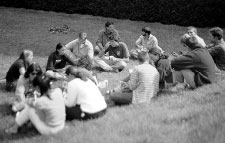
|
|
Linda Armstrong (left rear) Medical School Lawn At the beginning of the year, we used to sit out on the grass at lunchtime. It was a little bit like Camelot. We had to go to anatomy lab right after lunch, or we were coming right from anatomy lab, depending on the day— so it was a wonderful time; we were making new friends and feeling happy to be there. The weather was very symbolic: when it changed, it was kind of like we couldn't play around anymore. We started having to work a lot more and started into finals. This day, I was so happy to be in the sun. I had such a feeling of promise and comfort that there were these really good people around me. We changed so much during the 10 months of first year. I know when we come back as second-years we won't sit on the lawn in the same way, but that's okay. |
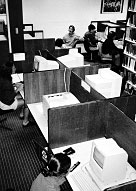
|
|
Jennifer Plant (center rear) |
|
We usually get a break from class every hour, and oftentimes there's an exodus to the library or to the student lounge so we can check our e-mail. We get our quiz results and most other official communications by e-mail. There's also a lot of correspondence with professors that way. Even a lot of the communication amongst our classmates goes on over e-mail. By the end of the year, I hadn't memorized some of my really good friends' phone numbers, because most people really aren't home all that much. But they're usually near a computer. I'd probably be amazed if I could calculate the amount of time that I spent—or wasted—on e-mail this year. |
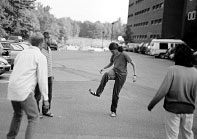
|
|
Sarah Conley (center) |
|
I wasn't really thinking about anything when this picture was taken—that's kind of the point of "hacking." It's a good way to take a break from sitting still in a lecture and do something completely different. This was pretty typical, although the hack usually spends about the same amount of time on the ground as it does in the air. I always carry my hack around in my backpack, mostly for the potential of being able to hack. It's like a reminder that I used to have leisure time in a previous life. |

|
|
Junko Ozao |
|
When you look at the slides in the beginning, you have no idea what you're looking at. It looks like a mass of colors, circles, dots. Then by the end, you realize that the cross section of tissue you're looking at is from the liver, for example, and that the liver is made out of hepatocytes. I'm a very picture- oriented person— some of my background is in art history—so I like visual learning. The forms of a painting carry meaning, and in the same way, when you look at a slide, you have to look at the forms and see what those forms tell you about the tissue's function. I enjoyed that part of the lab. |
A transformational experience
"The thing that really interested me was when people were either really excited or very engrossed in what they were doing," says David Holznagel, the photographer whose work is featured in the adjacent article. He tried to "capture what that person was thinking, or maybe what we were all thinking but one person was expressing more than the others."
Holznagel just completed his first year at Dartmouth Medical School— a year that he spent as both a medical student and a photographer. He came to DMS as a self-taught but experienced photographer, who had had his work published in a book and a magazine. He'd already planned to document the experiences of his classmates when he learned that DMS offers an elective called Creativity, designed to encourage students to pursue an interest outside of medicine. The class was essentially an independent study that allowed him to follow his photographic muse.
"I was thinking I would just kind of capture the experience, whatever came up in front of me," says Holznagel. But as the year progressed, he found that his project was proving to be "a transformation process for me, on top of medical school, because I started to look at the way people interacted and the way people dealt with their environment."
"One of my goals was to take candid photos," Holznagel explains. So he avoided setting up obtrusively, sometimes arriving at a venue early to adjust the lighting. "I didn't want someone suddenly changing what they were doing because I just raised my camera to my eye."
Holznagel shot over 900 photos in the course of the academic year. He carried at least one camera around his neck every day and often had as many as three with him. His classmates became habituated to being in his lens, enabling him to work inconspicuously. "I think a lot of my classmates weren't even aware after a time that I was taking pictures."
The only major component of the year that Holznagel didn't capture on film was a course called "On Doctoring," in which first-year students gain clinical experience by working with a community practitioner. "There is a lot of trust and confidentiality involved in the patient-doctor relationship," says Holznagel, "and bringing a camera in might seriously hinder an honest interaction."
He got encouragement from many quarters (including financial support from Dartmouth Medicine). He received permission to photograph in the labs, even the anatomy lab—although all those photos had to be approved by the anatomy department. "The professors thought it was great that I was taking pictures and really supported the idea," he says. He estimates that he spent nearly a thousand hours on the project.
The result was not only a set of photographs but also a new understanding for Holznagel. "Many of my pictures were what was occurring around me, and so in that sense this project is subjective. . . . However, at other times I would change what I was doing. . . . In lab, I would stop, walk around, and see what other people were doing, which was nice because it gave me a perspective outside my view, my microscope."
He became interested in the patterns that people created as they went through the year—the ways they arranged themselves in class or positioned themselves while talking— and he sought to capture those in his photographs.
"What I was trying to get at was the general idea of what we were going through, more than what it was like for one person," he says. "At the same time," he adds, "we are all individuals, and our story as a whole, as a group, is our story as individuals."
Jonathan Weisberg

|
|
David Holznagel |
|
I decided this would be a great day to take pictures. The sun woke me up early, and it was a beautiful, blue-sky morning. I spotted the reflection of Baker Library in the Hanover Inn window, the flowers in the flower box, and the rocking chairs. It looked great, but I thought the picture needed one more element. So I set everything for the lighting, focused, and put my camera on a timer. Then I leaped over the railing, sat down in the rocker as fast as I could, and tried to look calm. I was thinking maybe this would be a picture I could send home to Mom. The window has a reflection, and the mood I was trying to get with myself was reflection: sitting back and considering the possibilities. This was at the beginning of the year, and I wasn't quite sure what lay ahead of me. |
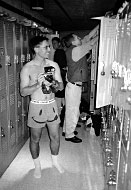
|
|
David Holznagel |
|
Due to time and space constraints before anatomy lab, we change into our scrubs in the hallway. One day I sent an e-mail to all my classmates, saying "I'm going to be photographing right before anatomy lab—if anyone feels uncomfortable with this, please tell me and I won't include you in the pictures." I didn't want anyone to feel they were being chased by my camera. I got the idea to try to make people feel more at ease by walking around in my boxer shorts, and I chose the loudest, brightest pair I had. It was my way of saying "I'm not trying to make anyone look more foolish than I am." That was the one time I broke my own rule of trying to be incognito, but it was just to make people continue what they were doing. Then a classmate asked to borrow my second camera and take pictures of me taking pictures. I thought to myself, "There are probably going to be only a few pictures of me the entire year, and this one is going to be funny." |

|
|
Youssef Tanegho (far left) |
|
After the white coat ceremony, some people went off with their parents to celebrate. Others left with spouses. The people in this picture noticed that we were all left as "orphans," so we decided to stay with each other. It had been a good day so far, and it continued to be enjoyable with the company I had for dinner. We were really still discovering each other as a class, and this get-together helped move that process along. Just before the picture was taken, I had been having a provocative talk with Eric [Quinones, sitting at the head of the table]. |
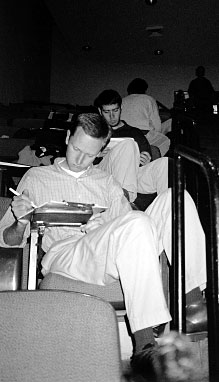
|
|
Ben Lannon |
|
I'm taking one of our biweekly Monday quizzes here. They are designed to help students stay on top of the work by breaking it down into smaller units. Unfortunately, they cause most people to stress all weekend before the quiz. I was probably trying to remember some minor detail on which I had spent 10 minutes out of 36 hours of studying over the previous weekend. I am a man of ritual and have an easier time recalling information when I am in the same place that I was when I learned it. So I always sit in the same seat. Also, the seats in Kellogg Auditorium are old and many of the desks are wobbly, and some seats are in a bad position to either see or hear. Early in the year I sampled many seats to find one that would suit me. This one was the best. I have already begun picking out a chair in Chilcott for next year. |
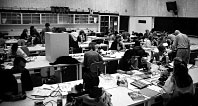
|
|
Paul Testa (far left foreground) |
|
You don't really go to medical school for the first two years. I'm looking forward to the clinical years with a passion. I look at these two years as a flaming hoop that I have to jump through. And CTO Lab definitely wasn't my favorite part of the year. We didn't need the professor to do it, and we didn't really work together. We were just learning in the same space. I'm a lawyer, and law school has nothing on med school. I've never worked this hard before in my life. |
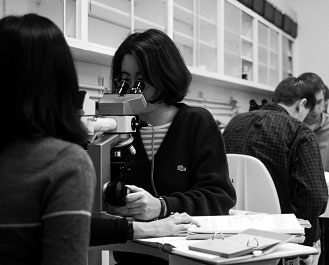
|
|
Julie Young (far left) |
|
CTO is kind of a rite of passage. It is a hard class with a lot of memorization. We'd look at slides of the things we were learning in class, and most of the time, honestly, we were sitting there going, "What's that?" Some people even call it the "What's that?" class. Leslianne [Yen, facing Young] was funny, because she'd always say things like "What's this mush right here?" That's the way we were talking in the beginning. Then after a while we'd say, "What is this basophilic area?" We'd be able to use more scientific terms and things. The first year of medical school is like learning a foreign language on top of learning a lot of information. |
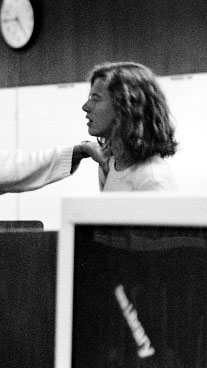
|
|
Elizabeth Bassett (right) |
|
Ilona [Csapo, left] is a couple years ahead of me. You can probably tell that she's saying, "It's okay, everything's okay." Knowing her made me much less uptight about first year and all of the quizzes and the hurdles they make us jump. From her experiences, I can think ahead and figure where I want to be in another year. It felt a little less chaotic. I think the key was trying to minimize the stress, because, unless you have help doing that, it's really hard. It was a gift to know someone who had been through it. Of course, sometimes she'd tell me, "You can skip that lecture." |
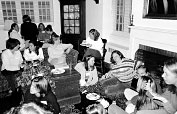
|
|
Sara Pietras (on the right of the couch) |
|
This was the American Medical Women's Association dinner. I had seen their display at orientation, and it sounded like an organization I wanted to join. We all brought a dish, and it was like a big dinner party. I was sitting next to Amy Madden, and I hadn't talked to her at all before, even though she was one of my classmates. I was really enjoying talking to her; she's done a lot of cool things. It was also good to hear about the professors' experiences. I think we have a much easier time than they did, but it's still good to socialize on a different level with women and hear their thoughts. |
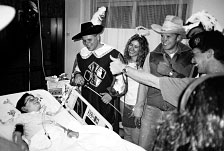
|
|
Seth Crockett (in the light-colored hat) |
|
I was glad that we were able to make this little boy laugh. A group of us were visiting the kids in CHaD on Halloween and bringing them little toys and gifts to help them celebrate a holiday they would otherwise miss. It was certainly a more rewarding experience than studying for a quiz or exam. It was difficult to see some of the kids who had been there for a long time and to see how sick they were, but it was still easy to act goofy. I think we were more effective in our efforts because we weren't doctors. That night we were just kids, like them. |

|
|
Jennifer Plant (right foreground) |
|
This was a short break in the middle of exams, when you sort of don't know what to do with yourself. There's that little bit of you that feels like you should be studying, but there's most of you that just wants to get the test over with. Some people were playing football, and we were just standing around not talking about the test. I think by that point a lot of the tension was gone, and I felt more excitement about almost being done. There certainly were people who dreaded tests, but I usually felt like most of the hard work was done by that time. |
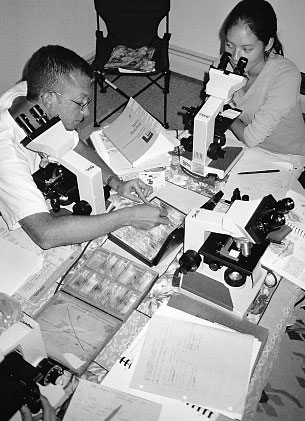
|
|
Paul Testa (left) and Junko Ozao (right) |
|
Testa: Four of us set up a mock "histology practical." We did round robins, where we each set up a slide and the others would guess what it was. Then we'd say "You're right" or "You're wrong" and point out notable sections. I spent a huge amount of time studying alone with a book, but this had a social aspect. It was fun. Ozao: It was a lot of fun. There was a lot of stress, but there were a lot of jokes, too. This was just before the exam, so by that time we had racked up a lot of hours studying, and everyone was kind of slap-happy. People were getting a little bit crazy late at night, joking about the slides. We were just working through the material, but it was so much more fun to do it with other people. |
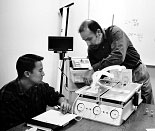
|
|
Clarence Miao (left) |
|
All of the first-year students had to go to Borwell that morning for three different tutorials that gave us a more tangible feel for the things we were learning in lectures. It was exciting to see some of our knowledge being applied to an actual medical device. Cardiovascular physiology was one of my favorite sessions, because the faculty found different ways to approach the subject. Someone once told me that teaching is merely the act of saying the same thing over and over in different ways. This picture depicts that maxim for me. |

|
|
Melissa Woo (far right) and Katie O'Donnell (far left) |
|
Woo: This was a skating party to benefit Toys-for-Tots. O'Donnell: We brought gifts for kids. MW: I brought Play-doh. KO: I brought a Mr. Potato Head. MW: Mike [Morris, second from the right] is the one who organized it, and he doesn't skate because he's from Arizona. KO: We were all trying to teach him to skate backwards; I think that's why we look so awkward. I don't think we ever got him to skate backwards either. MW: It was a good party, it was fun. KO: It was good because a lot of people from different classes were there. It's one of the few events that the whole med school gets together and does. I talked to Karen, a third-year who just finished a peds rotation. It was good to meet the people above us and see what's going to go on. They're our best resource at school. And good mental-health supporters as well. |
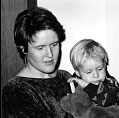
|
|
Riki Kveraga |
|
This was the first interaction between my two worlds, and I remember I was very happy. I went there with my two boys, and they got to meet some professors and other students. There's not much else that I do besides my medical work and my family. They're both so time-consuming that every minute is critical. It was nice for my kids to be invited to a school function. My thinking about the future is really based on my family. When I came to medical school, I was very interested in ob-gyn. But I've heard the residency is ridiculously difficult, so I've been thinking about emergency medicine or radiology, even though they may not interest me as much. |
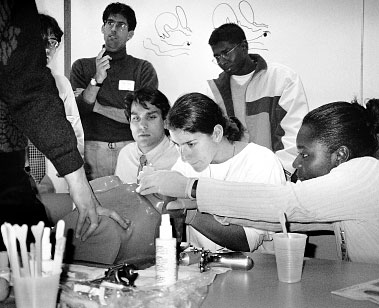
|
|
Tim Pieh (rear, with name tag) |
I went to the Women's Health Skills Night to get a jump on learning the breast exam and pelvic exam. I like the technical procedures. It's a chance to get out of the lecture- hall style of medicine and remind yourself of why you are working away. It was real interesting. I was talking with the professor, Diane Harper, because I was used to the intubation procedure from my work as an ambulance attendant, and that has similar manual moves to the pelvic exam. And I wanted to know all the little details: What do you say when you're doing a pelvic? How do you make the patient feel as comfortable as possible? I had no idea if it's better to say less or more, or what are the best words to choose, or what's the tone you should take. She keyed right in on my questions and suggested a number of things that were definitely physician-style skills. I can't wait to get to that side of medicine, when, as we first-years say, the whole person will become involved. I was kind of impatiently waiting, I guess. |

|
|
Cecily Reynolds |
|
This was a Monday after quizzes were done. I was enjoying the break before the next class by reading the Sunday New York Times and emptying my mind of all classwork. It was a nice feeling to catch up on the world, which had a tendency to pass by pretty quickly. I knew school would demand a lot of concentration, so I had determined from the beginning to enjoy all the downtime I got and not get carried away by the pressure. Carrying the newspaper or crossword puzzle with me was one of my strategies for escape, allowing me to do something nonacademic in those periods between class. |
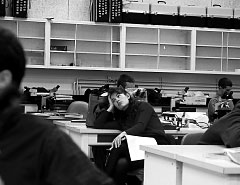
|
|
Courtney Voelker |
|
I was very tired that day. CTO lab gets a bit drawn out sometimes. This particular class went on and on and on. But it was a wonderful course all the same, and it really has been the most valuable one. I'm the type of person who really enjoys the lab, as much as it doesn't look like it here. It's just a very tiring schedule during first year. It's the routine and the amount of material that's coming at you at once. Every minute is taken up by some sort of learning, which is exciting, but, at the same time, you have to get your sleep sometime. |
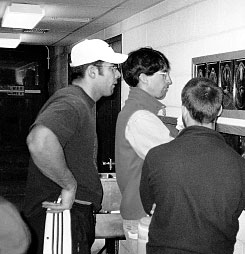
|
|
Tim Pieh (center) |
|
Those aren't actually MRIs. An inmate who was put to death allowed his body to be frozen and then sliced from head to foot in small slivers. Those are photographs of the body, so you're getting the real version of the MRI. It's more personal; that's one individual. You can even see that his hair has been shaved and then grown a little bit postmortem. The three of us pictured here are roommates—three out of a house of five—and we're kind of the delinquents. But we were all getting together to crank through for one of the practical exams. We were quizzing each other when Dr. Binder [an anatomy professor] came down and pointed to three things and said, "What's this? What's that?" Two out of the three were actually on the test, so we were in the right place at the right time—which was rare for us three. |

|
|
Sanjoy Bhattacharya (right) |
|
We're looking at a rack of test tubes with a urine sample. Typically, the urine sample is diluted, then you add a certain reagent to figure out what concentration of the urine sample gives you a positive result. When you see a positive result, based on the concentration, you determine whether the person has a bug in their urine and whether the levels of the bug are pathological. I don't know exactly what clinical practice will be like, but I do know that physicians usually don't do these things. You order a test and it comes back to you. But there could always be one night when no one is around, and you need to run a test yourself. |

|
|
Angela Sanchez |
|
I've always felt at home on the stage, so this was one of my favorite moments of the entire year. It was the annual Dermatones Spring Concert, which is an opportunity for medical students to showcase hidden talents. Shea Gregg, Aubrey Ingraham, Doug Franz, and I did two very loud Janis Joplin songs. So I got a chance to show my loud, obnoxious diva side as opposed to my usual subdued side. I was four months pregnant in this picture, which makes it even more out of character to be so Janis-like! |
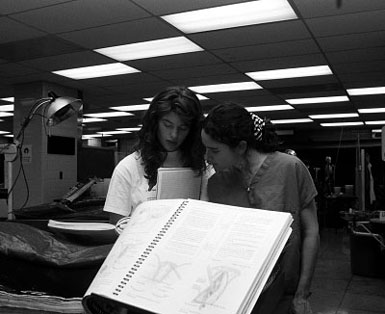
|
|
Courtney Voelker (left) |
|
We're studying in the anatomy lab, using the atlases and coordinating the information there to what we'll have to identify during the exam. It's very different in a book, so you have to focus on the structures in the body—you need to learn from them. We studied our cadavers from the cranial nerve all the way to the extensor and flexor muscles of the big toe. I think we all were very sensitive and respectful of the fact that these people gave us this gift. Once, we were working on a female cadaver and we had to roll her over. I was helping to move her arms, and, as I turned her hand over, I realized her fingernail polish was the same color as my fingernail polish. It was moments like that when it really hit me. This lady was 84 and still liked to look nice. It was very moving because— well, I don't want to say you ever lose the humanity of it, but her humanity became much more present. |
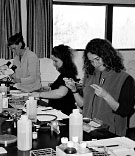
|
|
Jennifer Rhodes (right) |
|
Microbiology lab was always sort of like a puzzle. You had to figure out what was in front of you, and you learned very hands-on stuff that will be useful in the future. Generally, we had an idea of what bacteria we'd see, based on what we'd been studying that week. But first you find out if it's a rod or a cocci based on the color of your Gram stain. Then you do more tests further down a tree of possibilities. You need to do a lactose test or a different fermentation test, or you can do an oxidase test. You slowly narrow it down and narrow it down, until you get two possibilities. Then you do one more test and you figure out what it is. |
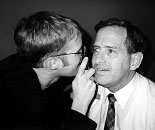
|
|
Seth Crockett (left) |
|
This was the day we were taught to do eye exams using an ophthalmoscope. It was part of the On Doctoring course. I remember this session pretty well, because I was getting quite frustrated since I was unable to see the fundus of the eye while practicing on other students. I was ready to give up, but Rich Douglas [right], my small-group leader, had me try one more time on him. Whether it was luck or good coaching, I finally got it—and was overcome with satisfaction. |
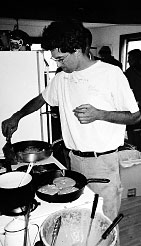
|
|
Tim Pieh |
|
This is at my aunt's place up in Breeman, Maine. When we had about a month of school left, and everyone was pretty burned out and exams were coming up, I just threw it out that people could drive up to my aunt's for the weekend—get out of Hanover and have a good time. About 20 students came and we had a lobster bake: You go down to the shore and build a threewalled fire pit. Then you layer seaweed and lobsters and corn and onions and potatoes and on top you put eggs. The next morning, I made pancakes for everybody. It really felt good, playing host and giving people a genuine break. I knew there was no doubt that they would get their batteries recharged. |
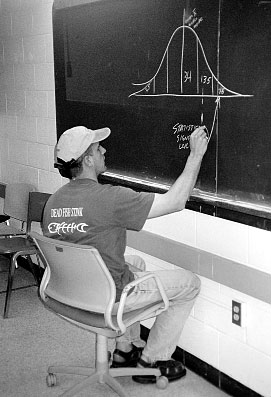
|
|
David Gibbons |
|
We'd been studying for the biostatistics final all day, and that's the reason I'm sitting down. The table was in the middle of the room, and we had rolling chairs, and I just didn't feel like getting up. So I swung around and pulled my rolling chair over to draw this picture. We would often start studying at about 7:00 a.m. and take an hour for lunch and about a half-hour for dinner, and we'd usually study until 9:30 or 10:00 at night. It's amazing to me that sitting down and studying can be such a great physical exertion. I mean, you're not out running a marathon or anything, but at the end of the day I was just as tired. |

|
|
Courtney Voelker (second from right) |
|
Each year it's an option for the class to give a memorial service for the cadavers we used in anatomy lab. Amy Madden organized the service for our year. We each brought a candle of a different shape and color, in order to represent each of the cadavers. As students, we had only known the cadavers by the diagnosis of their death and their age and gender, so it was really moving because this was the first time that we heard their names. I also spoke with the families of some of the body donors. Then afterwards, this group of us was helping to clean up. And for some reason we couldn't remove these candles. We were cleaning up everything else but these candles. Then we gathered around the table, but still none of us could blow them out. Finally, after the picture, we decided to blow them all out at the same time. |
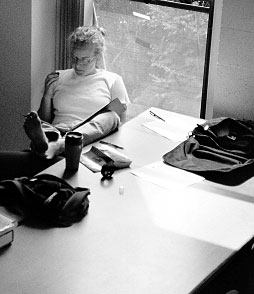
|
|
Margaret Thompson |
|
I spent a lot of hours in that exact spot doing that exact thing: studying. On this day, I hadn't taken a shower in a while and I hadn't been home in a while and I was just trying to get through what I knew I had to do. That was sort of my corner. I could put my feet up and spread my stuff out on the desk. I ate a lot of meals there, too. First year is not that engaging— you are just covering a lot of basics and so much new material. There were a few times I got excited about what we were learning, but most of the time I was just plugging away. I made a big transition coming to medical school, so I felt that I was turning away from other things in my life to study. It was hard for me to focus, but I found this to be the best place when I needed to buckle down. |
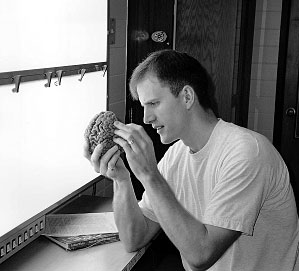
|
|
David Gibbons |
|
This picture was taken when we were studying for our lab practical in neuroscience. We'd been looking at MRIs and angiograms, and then we picked up the preserved brains they had there in the lab. What they do is stick them with little pins, and we identify the pins for the different areas. It was kind of difficult, but once you started to see the different shadows and such, you could pick out the various gyri and sulci. My initial impression was that neuroscience was going to be fairly straightforward and simple, but even just the gross anatomy of the brain is incredibly complex. Then you start to think about all of the connections just to move your hand: there are hundreds of signals and neurons—an incredible amount. And things like sight and hearing and taste and smell are even more intense and interesting than the movement of the body. It's just an immense amount to learn. |
Back to Fall 2000 Dartmouth Medicine
